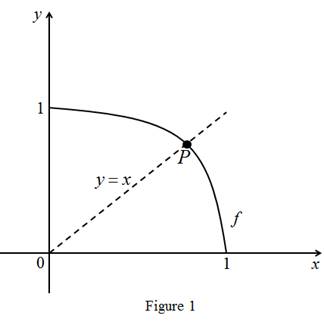
Concept explainers
(a)
To Sketch: A continuous function with domain [0,1] and range is also lies in [0,1]. It has fixed point.
(a)
Answer to Problem 8P

Explanation of Solution
The graph of the curve is
The function f continuous with domain [0,1] and range is also lies in [0,1].
(b)
To Draw: A continuous function with domain [0,1] and range is also lies in [0,1]. It does not have fixed point.
(b)
Explanation of Solution
There is no possible to draw the graph of the continuous function with domain [0,1] and range is also lies in [0,1]. It does not have fixed point.
Because, the “obstacle” is the line
(c)
To prove: Any continuous function with domain [0,1] and range in [0,1] must have a fixed point.
(c)
Explanation of Solution
Result used: The intermediate value theorem,
If
Proof:
Consider the function
Now need prove f has a fixed point that means if
Assume that
and
By the intermediate value theorem, there exist some number c in the interval
So
Therefore f has a fixed point c.
Hence proved.
Chapter 2 Solutions
Single Variable Calculus: Concepts and Contexts, Enhanced Edition
 Calculus: Early TranscendentalsCalculusISBN:9781285741550Author:James StewartPublisher:Cengage Learning
Calculus: Early TranscendentalsCalculusISBN:9781285741550Author:James StewartPublisher:Cengage Learning Thomas' Calculus (14th Edition)CalculusISBN:9780134438986Author:Joel R. Hass, Christopher E. Heil, Maurice D. WeirPublisher:PEARSON
Thomas' Calculus (14th Edition)CalculusISBN:9780134438986Author:Joel R. Hass, Christopher E. Heil, Maurice D. WeirPublisher:PEARSON Calculus: Early Transcendentals (3rd Edition)CalculusISBN:9780134763644Author:William L. Briggs, Lyle Cochran, Bernard Gillett, Eric SchulzPublisher:PEARSON
Calculus: Early Transcendentals (3rd Edition)CalculusISBN:9780134763644Author:William L. Briggs, Lyle Cochran, Bernard Gillett, Eric SchulzPublisher:PEARSON Calculus: Early TranscendentalsCalculusISBN:9781319050740Author:Jon Rogawski, Colin Adams, Robert FranzosaPublisher:W. H. Freeman
Calculus: Early TranscendentalsCalculusISBN:9781319050740Author:Jon Rogawski, Colin Adams, Robert FranzosaPublisher:W. H. Freeman
 Calculus: Early Transcendental FunctionsCalculusISBN:9781337552516Author:Ron Larson, Bruce H. EdwardsPublisher:Cengage Learning
Calculus: Early Transcendental FunctionsCalculusISBN:9781337552516Author:Ron Larson, Bruce H. EdwardsPublisher:Cengage Learning





